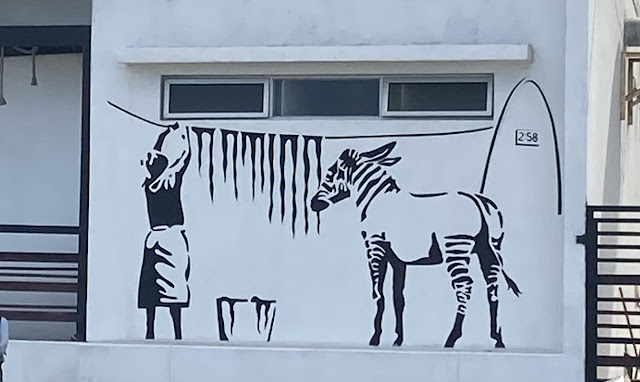Under the mistletoe
I never truly understood "rhythm" in dressage until I felt it. There's the theoretical knowledge that isn't hard to understand, but describing what a good rhythm feels like only goes so far. Feeling it is way better. When the normal physical rhythm of a horse gets disrupted, it could be a one-off oddity, it could be a chronic compensatory pattern, or it could be an acute injury. All of which make the rhythmic movement of energy less efficient.
It's not a stretch to think of our bodies as factories of rhythm, as well. Not just our physical movement, but cycles of sleep, inflammation, hormone presence/absence, temperature changes, etc. If all of the gears turn as they should, we stay dynamic in motion. If the rhythm of one gear gets a little wonky, things can start to rattle apart. Considering what we expose ourselves to, we're really pretty robust creatures. Rattles are caught and repaired even before we're aware of an issue at all. For me, cancer is an issue of self-repair.
It's not uncommon to hear from cancer patients that they never get sick. I fall into that category. I was good for one solid cold a year through college, then until my diagnosis in 2019, I could probably count on one hand how many tissues I've used for the sniffles. That said, since I've started using therapies that challenge my immune system more, I'm starting to feel what an immune system is supposed to do, and I've actually had more symptomatic colds. My immune system has been sticky and out of practice, so exercise to fever and recovery isn't a bad thing!
Mistletoe therapy is a pillar. That mistletoe, yes, muah. The toxic one, yes, muah. Even just as a plant, it's really, really fascinating and even more impressive as a cancer therapy. Luckily, there's a book to read about it because I'd have to rewrite the whole book here to explain it anyway. www.themistletoebook.com is where you'll find it.
The highlights: Mistletoe that is harvested at different times of year and from different host trees that offer different characteristics for differing types of cancer. A patient's cancer type, constitution, physical, and spiritual selves are all considered when choosing the mistletoe's host tree that would be most effective. Certain types of cancer tend to correlate with certain host trees. Cool, right?
The mistletoe is prepared into a teeny injectable dose that I inject subcutaneously usually every other day, sometimes 2 days in between. I've been on a supportive dose, which is basically where I'll have a reaction--a small red area around the injection site about the size of a quarter and a slight body temperature increase. Therapeutic doses are usually much bigger in dose and done either IV or directly into the tumor--these are only done under the guidance of a professional, as the dosing is increased very methodically, not done all at once. It's known to be a very safe therapy, however, even along side chemo and radiation, as the immune system is the self-limiting factor. I've only increased my subcutaneous dose too fast once and flattened myself for about 3 days with a fever. The whole point is to create heat (cancer isn't a fan) and create an immune response (cancer isn't a fan), but there's the mini-version of that (supportive, in which one still functions quite well) and the mega-version of that (therapeutic, in which one pancakes for a bit until the fever resolved). (Good thing I ride horses for a living and that I don't teach a writing class, huh?)
The take home that I've been thinking a lot about is fever suppression. Taking a drug to reduce cold/flu symptoms rather than allowing the immune system to completely cycle and do its thing. Fever sucks, but an immune system that gets lazy isn't great either.
Ok, enough of that.
Our little neighborhood is Tijuana is very quickly growing on me. Today is our only day that we don't go to the clinic, so we were able to go to the beach this morning and go out to breakfast. All of the vendors were just getting set up, it was quiet, the ocean was the biggest energy there (usually it's trumpets), and art is on every flat surface.
 |
| No solicitors |







Comments
Post a Comment